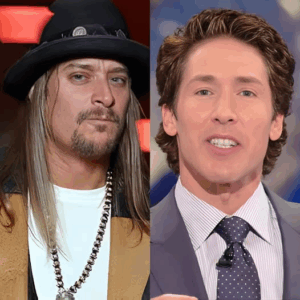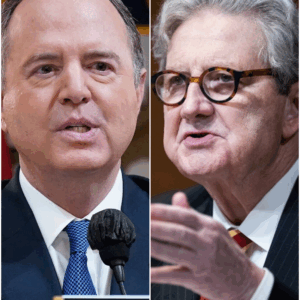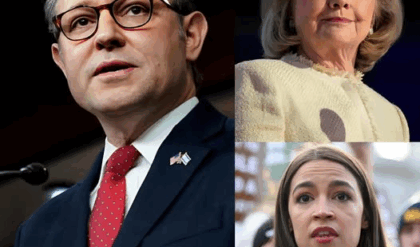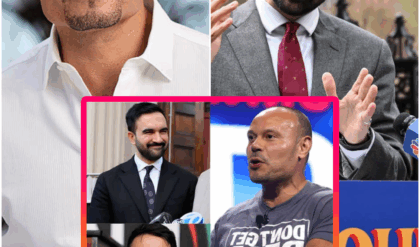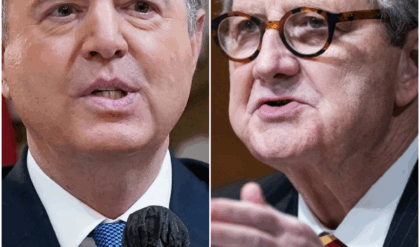Here’s a scene you’ve watched a hundred times if you’ve spent enough hours in hearing rooms and greenrooms: a witness with a flair for performance, a committee hungry for a moment, and a gallery of reporters quietly betting which line will make the chyron. But Tuesday morning in Washington didn’t just ask for the chyron; it demanded a poster. Dan Bongino—ex–Secret Service, now full-time broadcaster—slapped a blood-red binder onto the witness table, and the sound ricocheted off stone like a starter pistol. On the cover, in font big enough to read from the cheap seats: 1.4 MILLION GHOST VOTES. If you’re allergic to theatrics, this was an EpiPen moment.
You know the cadence. The lights dim a notch. The room inhales. A screen flickers awake. But before the PowerPoint, Bongino aimed at a projected photo of New York City mayor-elect Zohran Mamdani and issued a line designed to outlive the day: “This man orchestrated the largest electoral heist in American history. Arrest that man.” The chamber erupted on cue—gasps, shouts, the sound of a thousand keyboards tattling to their editors. Washington has a muscle memory for spectacle. It’s also lousy at restraint.

Now, to the claims. Bongino said the red binder held six months of work by a nameless network—whistleblowers, cyber-forensic analysts, people he framed as “survivors of political intimidation.” That’s a cinematic coalition, and it would be compelling if even a sliver of it were verified. It wasn’t, at least not in the room. Still, what he displayed tracked with the modern mythology of election fraud: duplicate ballots, fabricated registrations, “AI-forged identities,” signature sheets repeating like wallpaper. He flipped pages with a prosecutor’s rhythm, punctuating with a palm slap that dared someone to object.
Behind him, a projection claimed to show internal logistics logs from a Queens shipping hub—shipments labeled “archival materials,” which Bongino asserted were ballots in disguise. The strongest allegation centered on a burned-out warehouse in Long Island City: sealed pallets of counterfeit ballots, accelerants detected by fire inspectors, cameras conveniently offline, heavy machinery heard the night before. He even offered charred fragments allegedly matching New York City ballot stock. None of this arrived with independent corroboration, but that’s the game with spectacle—you don’t lead with footnotes.
Then came the set piece tailor-made for social media: “Starlink Ghost Stack Footage.” Lights down. Thermal imaging up. A glowing roof, pallet-shaped heat signatures inside, and the suggestion—no, declaration—that ballots were being sorted after polls closed. It was the kind of grainy clip that lets people see what they already want to see. If real, it would be a scandal. If not, it was a very expensive screensaver. The room went quiet in that theatrical way hearings use to simulate gravitas.

Next chapter: the U-Haul angle. A spreadsheet of a dozen trucks, bulk rentals paid with prepaid cards, phone numbers allegedly brushing up against Mamdani’s political orbit, and traffic cameras catching two of those trucks headed toward the doomed warehouse on the wrong night. This is how conspiracy narratives are built—data points that feel mechanical and therefore honest. Trucks, logs, thermal imagery. It’s less “men in smoke-filled rooms” and more “guys with clipboards and burner phones.”
If you cover politics long enough, you develop a nose for the difference between revelation and packaging. This smelled like packaging: a lot of staging, a lot of sizzle, and a calculated demand for law enforcement to validate the script. Still, something real did happen next. Within an hour, FBI vehicles were seen at two sites in Queens: the warehouse ruins and a small campaign office linked to Mamdani’s volunteer network. Agents carried evidence bags. Spokespeople said nothing, as they do. The timing suggested interest, not endorsement. Agencies show up for many reasons—among them, to shut down fever dreams before they run a fever.
Mamdani’s team didn’t wait. They came out swinging—“100% fabricated,” no connection to warehouses, trucks, or fraudulent ballots, and a charge that Bongino was theatrically inventing a scandal for attention. That last part is not a crime, but it is a modern currency. The phrase “ghost votes” had already left the building by then, on its way into headlines, memes, and your uncle’s group chat.

Let’s pull back. America’s relationship with election fraud stories is codependent. The supply is abundant; the demand is emotional. What makes this iteration different is the scale of the claim—1.4 million “ghost” ballots in New York City—and the specificity designed to launder plausibility: serial numbers, thermal signatures, logistics logs, U-Haul receipts. Add a familiar villain (urban machine politics) and a familiar hero (the truth-teller with a binder), and you’ve got a plot built to travel. The question is whether it survives first contact with professional scrutiny.
Here’s the checklist that separates smoke from structure:
– Provenance of documents: Where did the logs come from? Who handled them? Can third-party auditors replicate the findings without access controlled by the accuser?
– Chain of custody on physical fragments: Who collected the charred “ballot stock”? How were they stored, tested, and matched to official materials?
– The warehouse fire: Fire marshal reports, insurance records, footage from nearby cameras that didn’t go offline, witness interviews, and incident timelines. “Unusual accelerants” is a phrase that bears burden.
– U-Haul rentals: Subpoena the rental records, link payment instruments to real people, map the phone numbers, and triangulate traffic-camera timestamps against GPS pings. Trucks are either somewhere or they aren’t.
– Thermal imagery: Starlink isn’t an earth-observation platform in the way the presentation implied. If a commercial or government sensor captured that heat map, identify the satellite, the pass time, the resolution, and the analyst who processed it. Thermal blobs are notorious Rorschachs.
– Vote tallies: If 1.4 million ballots were injected, precinct-level canvass reports, ballot inventory controls, and reconciliation sheets should scream. Audits and risk-limiting checks are built to catch volume anomalies. Show the mismatch.
If the evidence clears even half those hurdles, you’ll see the machinery of the state engage with force, and the story will belong to prosecutors. If it doesn’t, Tuesday will be remembered as immaculate political theater—well-lit, well-timed, and empty at the center.

Two other realities deserve space here. First, hearings are stages, not courts. The incentives tilt toward viral confrontation, not careful adjudication. Second, election systems are messy and mostly boring. Paper trails, barcodes, bipartisan canvasses, reconciliation logs—unglamorous safeguards that don’t trend, but do work. When fraud happens, it tends to be local and countable, the kind that yields to spreadsheets and subpoenas. Claims of million-scale ghost ballots require a bureaucracy of complicity that never seems to leak in the right direction.
As for Bongino, he knows the business. He understands that narrative gravity beats footnotes nine times out of ten. The red binder is a perfect prop: tactile, photogenic, easy to point at, impossible to fact-check in real time. “Arrest that man” is a perfect line: decisive, moral, clipped. These are features, not bugs. If you’re trying to force the news cycle to cover your claims, you don’t whisper.
And yet skepticism is not cynicism. If there’s a real thread in that binder, it deserves to be pulled by people who can separate a pattern from a pile. Voters deserve confidence that their ballots aren’t props for someone else’s ambitions. Candidates deserve fair fights. The country deserves better than grainy heat maps passed off as smoking guns.
So where does that leave us? With a phrase that will linger (“ghost votes”), a clip that will be replayed (the binder slam), and a binary that will tempt pundits to pick sides before the facts slow-walk in. My advice, forged from too many hours in too many rooms like this: wait for the paperwork. Not the presentation deck—the affidavits, the lab reports, the matching records that withstand hostile cross-examination. Believe the receipts, not the rhetoric.
If those receipts materialize, the fallout will be enormous, and it should be. If they don’t, file Tuesday under Washington’s favorite genre: performance masquerading as revelation. Either way, the lesson holds. Democracy isn’t defended by the loudest person in the chamber. It’s defended by the quiet systems that outlast them—the ones that count, reconcile, verify, and, when necessary, prosecute. The rest is theater. Some days it’s gripping. Most days it’s just a well-produced noise.
News
The auditorium glitched into silence the moment Joel Osteen leaned toward the mic and delivered a line no pastor is supposed to say in public. Even the stage lights seemed to hesitate as his voice echoed out: “God will NEVER forgive you.” People froze mid-applause. Kid Rock’s head snapped up. And in that weird, suspended moment, the crowd realized something had just detonated off-script.
The crowd expected an inspiring evening of testimony, music, and conversation. What they got instead was one of the most explosive on-stage confrontations ever witnessed inside a church auditorium. It happened fast—36 seconds, to be exact.But those 36 seconds would…
The room stalled mid-breath the moment Mike Johnson snapped open a black folder that wasn’t on any official docket. Cameras zoomed. Staffers froze. The label on the cover — CLINTON: THE SERVER SAGA — hit like a siren. Johnson leaned toward the mic, voice sharpened enough to scratch glass, and read a line that made every timeline jolt: “Her email is criminal.”
Here’s the thing about made-for-TV government: it knows exactly when to hold a beat. Tuesday’s oversight hearing had the rhythm down cold—routine questioning, polite skirmishes, staffers passing notes like we’re all pretending this is not a stage. And then Mike…
🔥 “THE SMILE FLICKERED—AND THE ENTIRE STUDIO FELT IT.” — Laura Jarrett walked onto the Saturday TODAY set with the kind of calm, polished glow producers dream of. Cameras glided, lights warmed, and the energy felt like a coronation. But right as she settled between Peter Alexander and Joe Fryer, something shifted — a tiny hesitation in her smile, the kind that makes everyone watching sit up a little straighter. And then it came: a voice from outside the studio, sharp enough to snap the broadcast in half. For a full second, no one moved.
Here’s the thing about TV milestones: they’re designed for easy applause. A new co-anchor takes the desk, the chyron beams, the studio lights do their soft-shoe, and everyone is on their best behavior. It’s a ritual as old as morning-show…
🔥 “THE ROOM STOPPED LIKE SOMEONE CUT THE OXYGEN.” — What’s racing across timelines right now isn’t framed as a speech, or an interview, or even a moment. It’s being told like a rupture — the instant Erika Kirk, normally armored in composure, let a single tear fall while standing beside Elon Musk. Witnesses in these viral retellings swear the tear didn’t look emotional… it looked inevitable, like something finally broke through her defenses. And when Musk turned toward her, the entire audience leaned in as if they already knew the world was about to shift.
It was billed as a calm forum on human rights—an hour for big ideas like freedom, transparency, and the obligations that come with having a public voice. The stage was washed in soft gold, the kind of lighting that flatters…
🔥 “THE ROOM WENT DEAD IN UNDER A SECOND.” — What unfolded inside the Senate chamber didn’t look like a hearing anymore — it looked like a trap snapping shut. Adam Schiff sat back with that confident half-smile, clutching a 2021 DOJ memo like it was the final move in a game he thought he’d already won. Staffers say he timed his line perfectly — “Your rhetoric ignores the facts, Senator. Time to face reality.” But instead of rattling Kennedy, something in the senator’s expression made even reporters lean forward, sensing the shift before anyone spoke again.
It didn’t look like much at first—another oversight hearing, another afternoon in a Senate chamber where the oxygen gets thinned out by procedure. Then Adam Schiff leaned into a microphone with a lawyer’s confidence, and John Neely Kennedy pulled out…
🔥 “THE LIGHTS WENT DARK BEFORE ANYONE SPOKE.” — The studio crowd thought they were about to watch another rehearsed network segment… until David Muir stepped forward without a script, Rachel Maddow folded her notes in half, and Jimmy Kimmel whispered, “We’re not doing it their way tonight.” For one suspended second, every producer in the control room froze. The three biggest names in American media were no longer smiling — they looked like people about to detonate a truth they’d been forced to swallow for years.
It landed like a clean snap in a quiet room: David Muir, Rachel Maddow, and Jimmy Kimmel staring down a camera and, by extension, an entire industry that taught them how to stare down cameras. No stagecraft, no corporate sheen….
End of content
No more pages to load
